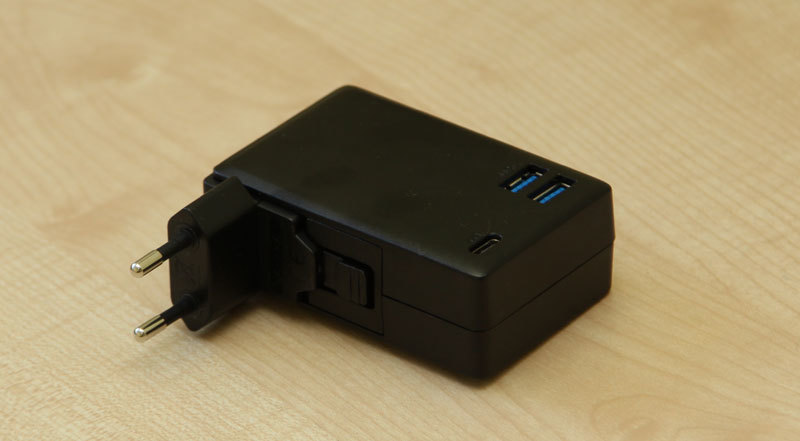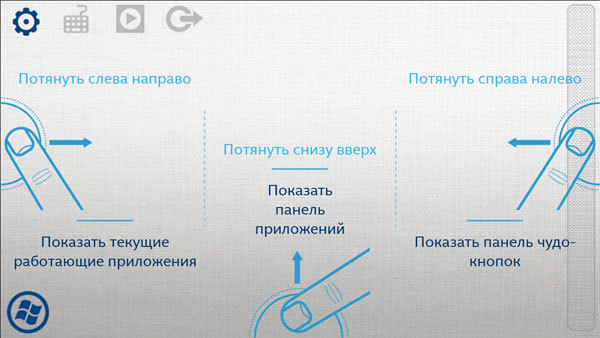Intel Compute Stick with Core processor. We test the kid for boldness

The first-generation Intel Compute Stick mini-computers based on the Intel Atom appeared on sale early last year. At the same time reports on their testing appeared on many specialized sites. In most cases, the verdicts were similar: “interesting, but like an amateur and too weak hardware to be considered a full-fledged PC”. Hearing the announcement of the new Compute Stick with Intel Core inside, the first thing I thought was: it is necessary to check, how is your baby doing now with performance? Did he get rid of his "childhood diseases"? If someone is waiting for a quick response, then it is purely positive. Well, the details under the cut.
Unpacking and specifications
The Intel Compute Stick comes in a nice, compact plastic bag. Accessory kit: power supply with a variety of plugs to choose from, a short HDMI extension cable, power cable.

At the first acquaintance, the cable surprises with its thickness - more than 6 mm - and the corresponding rigidity. The fact is that, taking into account the experience of previous Stick'ov, the developers have placed in the power supply USB hub connected to the device, so the number of lived in the cable has increased. Thus, USB ports have become more convenient to use - at the cost of a thick and noticeable cable.
')

The new Intel Compute Stick line includes three models : two based on the Core m3 processor (with and without Windows 10) and one for the Core m5, without Windows. I got into the hands of the Windows-version, all the main characteristics, with the exception of the processor, the line is the same.
| CPU | Intel Core m3-6Y30 (2 cores, up to 2.20 GHz) |
| Graphic subsystem | Intel HD Graphics 515 |
| Built-in storage | 64 GB (Kingston M52564) |
| Memory | 4 GB LPDDR3-1866 |
| Video output | HDMI 1.4b |
| Memory cards | MicroSDXC with UHS-I support |
| Network interfaces | Intel Wireless-AC 8260 + BT 4.2 |
| USB ports | 3 x USB 3.0 |
Compared to the previous generation, the Compute Stick was “pumped” in almost all indicators, which promised a significant performance improvement. Premonitions are not deceived.
Performance testing
Starting the benchmarks, I did not set myself the task of generating dozens of graphs and tables — surely, in a short time, the highly respected specialized sites already mentioned above. I was interested in one question: is the Intel Compute Stick a full-fledged PC or, like previous HDMI sticks, more like a set-top box with limited functionality. Therefore, I chose complex tests to compare the Stick with other categories of computers, and including my ultrabook-transformer based on the Intel Core i5 Ivy Bridge processor, to which I have no complaints about performance.


The first PCMARK 8 benchmark was launched (Home Accelerated mode). The result, as they say, is obvious: the increase in comparison with the ultrabook was almost 25%. I want to note that the result of the same test at the Compute Stick based on the Intel Atom was only 1078 parrots - here the difference is already several times.
The difference is particularly large, as we see, it turned out to be at the performance of the graphics subsystems. We know that Intel has worked hard on embedded graphics in Core processors, and after three generations this should be clearly seen. I armed myself with the benchmark Unigine Heaven Benchmark 4.0 , and this is what happened.
| Intel HD Graphics 515 | Intel HD Graphics 4000 | |
|---|---|---|
| Medium FPS | 7.0 | 2.3 |
| Min FPS | 5.1 | 1.8 |
| Maximum FPS | 12.5 | 4.2 |
| Result | 176 | 59 |
Do not be confused by the meager performance of the frame rate - the test is really very difficult, in addition, it was performed at the maximum quality settings. More important is the difference in the performance index of the two video chips. Dry tsifir is confirmed by the sensation of viewing HD-resolution video through a Compute Stick: no brakes were noticed.
For comparing the Intel Compute Stick with other computers, the SiSoftware Sandra 2016 benchmark was used (integrated testing). According to the test results, Stick received 3.79 KPT (and my ultrabook - 3.4 KPT). Looking at the results plate, I found that this order of magnitude is characteristic of desktop PCs with Core i5 processors of the third or fourth generation with embedded or average discrete graphics. Not to be unfounded, I will give an example of a configuration that has exactly 3.79 KPT: ASRock H81M-VG4 R2.0 (Intel Core i5-4460 CPU @ 3.20GHz; 2x 8GB Kingston; WDC WD15EARS-22Z5B1; NVIDIA GeForce GT 610) .
Now I finally made sure that the Intel Compute Stick with an Intel Core processor has a performance comparable to a regular home PC. Now it remains to understand how to adapt to its small size.
Intel Remote Keyboard
If you are going to use the Stick as a home PC for the full program, most likely, without the traditional means of input, mouse and keyboard, you can not do - the benefit of connecting them is where. But for a lightweight version - viewing photos / videos, reeling on the Internet - there are more interesting ways to interact. I mean the program Intel Remote Keyboard .
The program name was chosen unsuccessful - in addition to the keyboard, it can be a remote touchpad and not only them. Client application can be installed on Android or iOS. The connection is made via Wi-Fi, at startup the client itself finds all available hosts and lists them. When you first connect to the TV, a QR code is displayed on which you need to point the camera of the smartphone.

Frankly, I initially treated the Remote Keyboard more like a toy, not very suitable in real life. However, after 5 short spells, I was so accustomed that I did not use any other controls. The touchpad of the 5.5-inch smartphone turns out spacious and comfortable, and the time delays are small enough for comfortable work. On Google Play, in particular, you can read conflicting opinions about this application. Indeed, to admit, sometimes it podglyuchivaet. Once connected, the Stick just turned off, to another, the program on the host hung dead, preventing me from doing anything. In the application, the shutdown or restart buttons of the computer do not work at all. But overall, the impressions were positive. Rewrite files, install programs, change system settings - it turns out that using the Intel Remote Keyboard is done easily and naturally.
Conclusion
Last year, THG website, in its previous generation testing report on Stick, sadly noted: “you shouldn’t expect Intel Compute Stick and others like it [in the near future] to replace your main PC”. If the venerable resource decides to test the new version, he will have to admit that he was wrong. Can-can. Now it's not about performance, but about usability - various accessories can be useful here.
Now let's talk about the shortcomings.
- Compute Stick is cooled by the fan; in advertising materials it is called “silent”, but we all know: a small fan is not quiet. Under load in a quiet room you can hear it clearly. In idle mode - almost there.
- Generally heats up the Stick decently, on stress tests - up to hot. Of course, stress is bad, but there is still something to work on, given that the space behind the large TV itself is not very comfortable in terms of climate.
- The power supply also heats up, and it also seemed to me flimsy, especially considering that USB devices are constantly plugged into it.
- If you want to use a USB hub, you will have to pull out the thick black cable that I had in the most visible place. You can hide the power supply for the TV, but then you will not get to the USB-ports.
But in general, I repeat, a full-fledged Windows-based computer that can be put in your pocket really took place. True, in another pocket you need to shove the power supply.
Source: https://habr.com/ru/post/372195/
All Articles